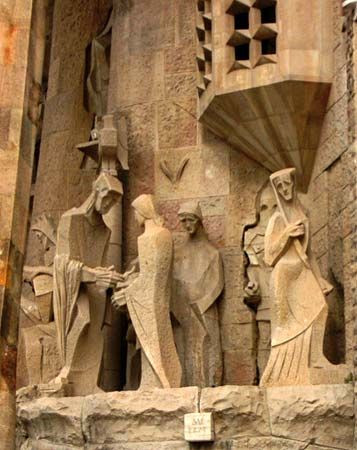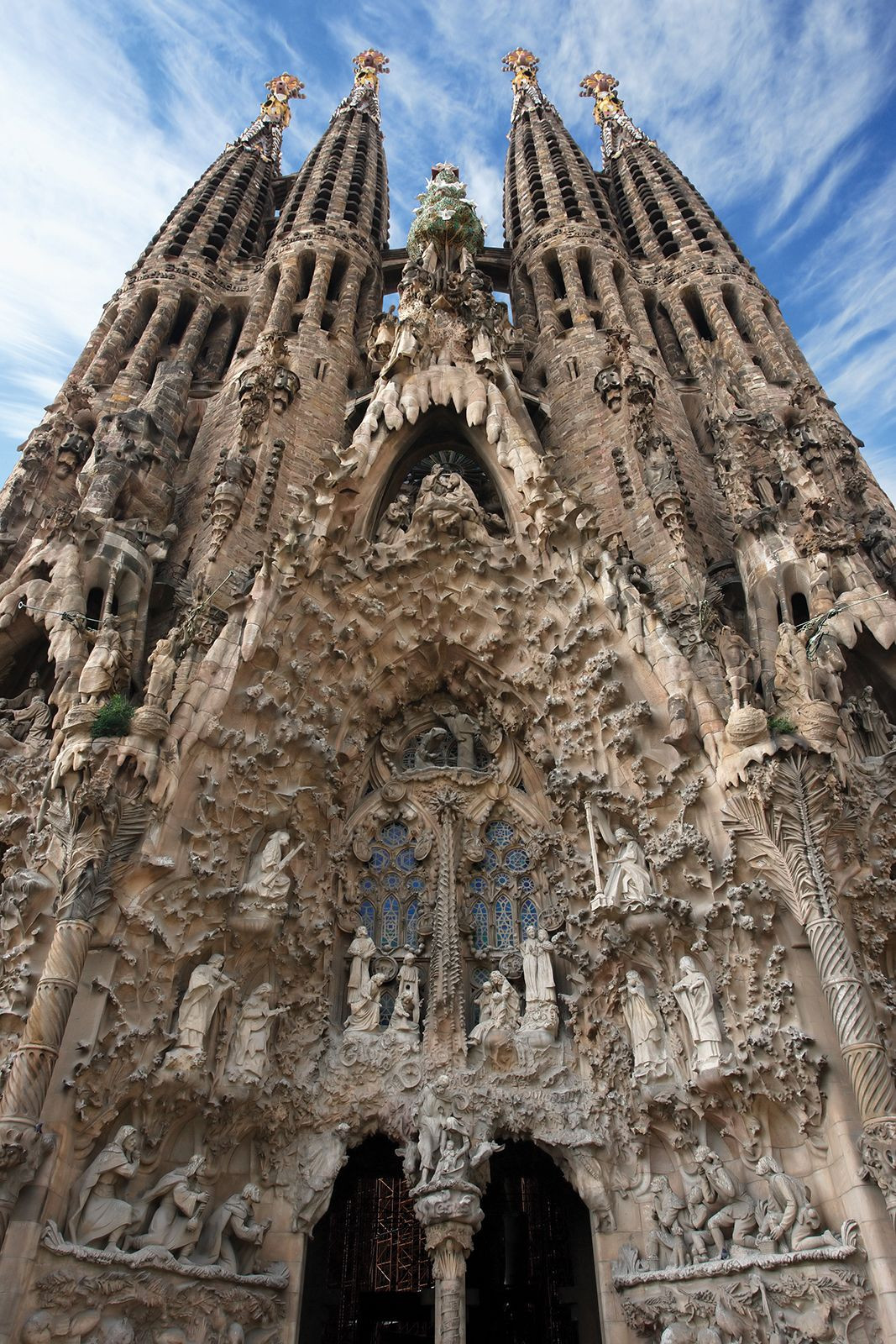Antoni Gaudí’s La Sagrada Familia Basilica stands as an iconic symbol of Barcelona and a testament to architectural innovation. This Roman Catholic minor basilica, a project begun in 1882 and still ongoing in the 21st century, is renowned for its breathtaking organic form and towering presence in the cityscape. Its bold flying buttresses and intricately designed towers make it an unforgettable landmark, drawing visitors from across the globe.
Originally conceived by Francisco de Paula del Villar with the aim to bolster Christianity in an increasingly secular Barcelona through donations, the project took a transformative turn in 1883 when Antoni Gaudí assumed the role of chief architect. This marked the beginning of a lifelong dedication for Gaudí, who would dedicate the remainder of his career to this ambitious endeavor. Gaudí revolutionized the initial Neo-Gothic design, envisioning a structure that could stand самодостаточно without the need for traditional internal bracing or extensive external buttresses.
Close-up of the Sagrada Familia showcasing its organic architectural details, Barcelona.
The outcome was an architectural marvel that defied convention, evolving into a symbolically rich “forest” of helicoidal piers, hyperboloid vaults, and hyperbolic paraboloid roofs and sidewalls. Gaudí’s vision was profoundly Expressionist, aiming to create a 20th-century cathedral that visually articulated the profound mysteries of Christian faith. His devotion deepened as he worked on La Sagrada Familia Basilica; after 1910, he dedicated himself almost exclusively to the project, eventually residing within its workshop on site.
Beyond his religious devotion, Gaudí was deeply involved in the Renaixensa, a Catalan artistic and political revival. This movement sought to rejuvenate Catalan culture and identity, which had been historically suppressed by the central government in Madrid. La Sagrada Familia Basilica became a powerful religious symbol for this Catalan resurgence in Barcelona, embodying the spirit of a people seeking to reclaim their heritage.
Gaudí’s original plans and models, tragically mostly lost during the Spanish Civil War, revealed a basilica capable of hosting 13,000 individuals. Based on a traditional basilica plan, the Latin cross layout is surrounded by porticoes on three sides. Each facade of La Sagrada Familia Basilica tells a significant story. The eastern Nativity facade celebrates the birth of Jesus, while the western Passion facade poignantly depicts his crucifixion. The Glory facade, intended as the main entrance, illustrates humanity’s path to divine glory.
 Sculptures of Pontius Pilate on the Passion facade of Sagrada Familia, Barcelona, Spain.
Sculptures of Pontius Pilate on the Passion facade of Sagrada Familia, Barcelona, Spain.
Sculptures of Pontius Pilate on the Passion facade of Sagrada Familia, Barcelona, Spain.
Dominating the skyline are 18 spindle-shaped towers, each with symbolic meaning. Twelve represent the Apostles, four are dedicated to the Evangelists, one to the Virgin Mary, and the tallest central tower will symbolize Jesus Christ. Each facade features four bell towers for the Apostles, with notable substitutions: St. Barnabas, St. Matthias, and St. Paul replace Judas, St. John, and St. Matthew. The central six towers, honoring Jesus, Mary, and the Evangelists, act as lanterns, illuminating the nave below with natural light.
At the time of Gaudí’s death in 1926, only the Nativity facade, one bell tower, the apse, and the crypt were complete. His disciple, Domènec Sugranyes, continued the work. Gaudí, interred in the crypt of La Sagrada Familia Basilica, was aware he wouldn’t witness its completion, famously stating, “The patron of this project is not in a hurry.” UNESCO recognized the significance of Gaudí’s work, designating the Nativity facade and crypt as a World Heritage site in 1984. In 2010, despite being unfinished, the church was consecrated as a minor basilica by Pope Benedict XVI, highlighting its religious importance.
 Nativity facade of the Sagrada Familia, Barcelona, showcasing its intricate details and sculptures.
Nativity facade of the Sagrada Familia, Barcelona, showcasing its intricate details and sculptures.
Nativity facade of the Sagrada Familia, Barcelona, showcasing its intricate details and sculptures.
Construction has proceeded since Gaudí’s passing, though not without challenges. The Spanish Civil War caused significant disruption and damage, including the loss of crucial original designs. Current work relies on surviving materials, reconstructions, and modern adaptations, some of which have faced criticism. Key milestones include the completion of the Nativity facade bell towers in 1930, the Passion facade towers in 1976, and the central nave vaulting in 2010. The tower dedicated to the Virgin Mary was inaugurated in 2021, and the towers of St. Mark and St. Luke in 2022.
Diagram illustrating the ongoing construction sections of the Sagrada Familia in Barcelona, Spain.
The remaining towers and the majority of the structure are projected to be finished by 2026, marking the centennial of Gaudí’s death. Upon completion, La Sagrada Familia Basilica is anticipated to be the tallest church edifice globally, continuing to stand as a symbol of architectural ambition, religious devotion, and Catalan identity for generations to come.

